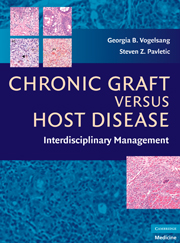Book contents
- Frontmatter
- Contents
- List of Contributors
- Preface
- PART I GENERAL PRINCIPLES
- 1 Historical Aspects of Chronic Graft versus Host Disease
- 2 The Pathophysiology of Acute Graft versus Host Disease
- 3 Pathophysiology of Chronic Graft versus Host Disease
- 4 Animal Models of Chronic Graft versus Host Disease
- 5 Incidence and Trends
- 6 Clinical Manifestations and Natural History
- 7 Risk Factors and Predictive Models for Chronic Graft versus Host Disease
- 8 Biomarkers in Chronic Graft versus Host Disease
- PART II CLINICAL MANAGEMENT
- PART III ORGAN SITE OR SYSTEM-SPECIFIC MANIFESTATIONS
- PART IV SPECIAL CONSIDERATIONS IN CHRONIC GVHD
- Index
- Plate section
1 - Historical Aspects of Chronic Graft versus Host Disease
from PART I - GENERAL PRINCIPLES
Published online by Cambridge University Press: 26 August 2009
- Frontmatter
- Contents
- List of Contributors
- Preface
- PART I GENERAL PRINCIPLES
- 1 Historical Aspects of Chronic Graft versus Host Disease
- 2 The Pathophysiology of Acute Graft versus Host Disease
- 3 Pathophysiology of Chronic Graft versus Host Disease
- 4 Animal Models of Chronic Graft versus Host Disease
- 5 Incidence and Trends
- 6 Clinical Manifestations and Natural History
- 7 Risk Factors and Predictive Models for Chronic Graft versus Host Disease
- 8 Biomarkers in Chronic Graft versus Host Disease
- PART II CLINICAL MANAGEMENT
- PART III ORGAN SITE OR SYSTEM-SPECIFIC MANIFESTATIONS
- PART IV SPECIAL CONSIDERATIONS IN CHRONIC GVHD
- Index
- Plate section
Summary
The scientific “discovery” of graft versus host disease (GVHD) mirrors some aspects of this devastating disease. It is based on an accurate observation but an error in interpretation. Similarly, GVHD and in particular chronic GVHD confront patients as a paradox. The symptoms appear just when he or she believes to be cured from the previously diagnosed lethal disease, that is, at engraftment of the healthy donor cells. GVHD can have devastating effects on patients, families, and transplant teams. Conversely, few “man made diseases” have provided so much insight into basic immunobiology as GVHD. It is the hope of this book, to turn the knowledge gained from chronic GVHD into benefit for all patients after a hematopoietic stem cell transplant (HSCT) and for the large population of patients with autoimmune disorders or cancer in general.
THE BEGINNING OF HSCT
The old Greek proverb that “war is the father of all goods” applies to few medical technologies as well as it does to HSCT. The recognition of late bone marrow failure from atomic bomb exposure in Hiroshima and Nagasaki had double consequences. Vast research funds were allotted to find tools to overcome this lethal late complication of high dose radiation exposure. Results came rapidly. As early as 1949, Jacobson showed in his pioneering work that mice survived otherwise lethal total body irradiation when their spleens were shielded during radiation exposure. Humoral, spleen-derived products were believed to be protective.
- Type
- Chapter
- Information
- Chronic Graft Versus Host DiseaseInterdisciplinary Management, pp. 3 - 7Publisher: Cambridge University PressPrint publication year: 2009



